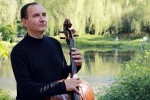Column Name
Title
Israeli-born Ohad Bar-David (Diploma ’83, cello), known as Udi, leads a double life. He is a member of the cello section of the Philadelphia Orchestra, which he joined in 1987, and he is also the founder, artistic director, and president of Intercultural Journeys, an organization dedicated to bringing people of diverse and conflicting cultures together through art and music. His work with this groundbreaking initiative has brought Bar-David to many tension-filled areas, domestically and abroad, where he has presented artistic events designed to serve as catalysts for peaceful dialogue and achieving mutual understanding. Through this work, he has collaborated with many of the world’s most renowned classical, jazz, and folk artists. Bar-David recently took time to discuss his fascinating musical and cultural explorations with oboe doctoral candidate Toni Marie Marchioni.
Body
Why were you compelled to form Intercultural Journeys?
It evolved in the late ’90s as a result of my wish to learn music of other cultures, coupled with my strong interest in conflict resolution. I was getting very disillusioned with political systems and started realizing that artists could be more involved in political dialogues, especially by creating a safe and trusting environment. I collaborated with an African-American classical and jazz player named Diane Monroe, a Curtis graduate who has excelled in both genres. We started putting programs together that brought Jewish Hasidic music and spirituals together and found ourselves exploring the commonalities between the two heritages. And, long story short, we put programs together in black churches and synagogues. Soon after, I also made contact with arguably the most prominent oud player in the world, Simon Shaheen, a Palestinian. We started presenting Arabic-Jewish music, and these programs brought Arabs and Jews together in the same room, which was a huge step forward. That led to a visit to an Arab-Jewish village near Jerusalem called Oasis of Peace, which is still, unfortunately, the only example in this part of the world where Arabs and Jews actually live together. A group of us from the U.S. spent time with them exploring the impact that music can have on bringing people together.
A very important visit followed to Thich Nhat Hanh, a Vietnamese Buddhist monk who’s one of the most prominent monks in the world. He really taught us about interconnectedness, how we are all related. It seemed a very natural segue into using music, the universal language, as a way to connect people. All of these opportunities started giving us, a group of people who shared the mission, incentive to make a more organized effort to really make an impact. Our goal is very simple—to break those cultural barriers. To paraphrase Martin Luther King Jr., people fear each other because they don’t know each other.
Can you describe a typical Intercultural Journeys event?
That’s really hard because we have found ourselves in many situations. For example, in [a] living room in San Mateo, Calif., I was there, just with my cello, in dialogue with American Jews and Palestinians who came from the West Bank and Gaza. Some painful experiences were described: people and their families really suffered a lot. Nevertheless, they chose to use dialogue as a way to move forward, and I used Arab and Jewish music as a way to bring the whole evening together. On the other side of the spectrum, we presented a series of concerts in which an Arab-Jewish ensemble and the Philadelphia Orchestra played klezmer works and Arab music based on Iraqi folk songs that were commissioned by and arranged for the orchestra. This was also very successful. In between, there are numerous events that we have presented on U.S. campuses, most in collaboration with Arab-Jewish student groups. I should also point out that we have collaborated with filmmakers, dancers, poets, storytellers, and scholars, so we have a very expanded network of relationships with the Native American, Hispanic, African-American, and Tibetan communities, as well as other cultures. Our collaboration on stage really does inspire.
How does your work with Intercultural Journeys fulfill you differently than your work with the Philadelphia Orchestra?
There are multiple aspects to that. We are living in a changing world, and that’s not a cliché anymore, it’s true: Economically, politically, culturally, it’s changing. The role of a musician and an artist is evolving. I feel that first of all, as musicians, nothing is complete. Even being in a fantastic orchestra like the Philadelphia Orchestra may no longer be everything for a musician because we might be required to do more in the future. Our audiences are dwindling, so we also have to serve as a bridge. When you go into communities—and I encourage every artist to do that—you present either music or visuals that are related to their culture, and you speak their language. And once you bring them in, you can present anything else, including all the masterworks that we have studied as classical musicians. I think this is a process that everyone has to do today, whether they are students, future professionals, soloists, or part of major orchestras. Since musical education is suffering in this country so much, we have the added responsibility of educating with our performances. I believe that we have to find a new balance in maintaining superior artistic performance with a social mission and civic service. It doesn’t matter whether I go to a school or play for 3,000 people in a concert hall, I always strive for superb artistic performance. I would never advocate for compromising the artistic quality or diluting it just for the sake of bringing people in.





